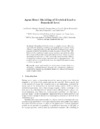Identificador persistente para citar o vincular este elemento:
https://accedacris.ulpgc.es/handle/10553/113968
| Campo DC | Valor | idioma |
|---|---|---|
| dc.contributor.author | Évora Gómez, José | en_US |
| dc.contributor.author | Kremers, Enrique | en_US |
| dc.contributor.author | Morales Cueva, S. | en_US |
| dc.contributor.author | Hernández Tejera, Francisco Mario | en_US |
| dc.contributor.author | Hernández Cabrera, José Juan | en_US |
| dc.contributor.author | Viejo, Pablo | en_US |
| dc.date.accessioned | 2022-03-08T12:10:34Z | - |
| dc.date.available | 2022-03-08T12:10:34Z | - |
| dc.date.issued | 2011 | en_US |
| dc.identifier.uri | https://accedacris.ulpgc.es/handle/10553/113968 | - |
| dc.description.abstract | Regarding electrical systems as complex systems offers new approaches for analysing, modelling and simulating those systems. Using software engineering techniques like Model Driven Engineering, a disag- gregated model for household electricity demand is created. The Tafat framework for simulating complex energy systems is presented, including the concepts of the metamodel, models and behaviours. A first case study simulating the load curve of 1000 households composed of five different social groups is discussed and compared with an aggregated curve. The model is able to represent the load curve of a sample of households using a bottom-up approach. | en_US |
| dc.language | eng | en_US |
| dc.subject | 330609 Transmisión y distribución | en_US |
| dc.subject | 330602 Aplicaciones eléctricas | en_US |
| dc.subject.other | Agent based model | en_US |
| dc.subject.other | Electrical system | en_US |
| dc.subject.other | Domestic load curve simulation | en_US |
| dc.subject.other | Residential demand | en_US |
| dc.subject.other | Demand side management | en_US |
| dc.subject.other | Appliances | en_US |
| dc.subject.other | Model driven engineering | en_US |
| dc.subject.other | Simulation framework | en_US |
| dc.subject.other | Demand size management | en_US |
| dc.subject.other | Complex system | en_US |
| dc.title | Agent-based modelling of electrical load at household level | en_US |
| dc.type | info:eu-repo/semantics/conferenceobject | en_US |
| dc.type | ConferenceObject | en_US |
| dc.relation.conference | CoSMoS Workshop 2011, European Conference on Artificial Life (ECAL11) | en_US |
| dc.investigacion | Ingeniería y Arquitectura | en_US |
| dc.type2 | Actas de congresos | en_US |
| dc.description.numberofpages | 16 | en_US |
| dc.utils.revision | Sí | en_US |
| dc.identifier.ulpgc | Sí | en_US |
| dc.contributor.buulpgc | BU-ING | en_US |
| item.grantfulltext | open | - |
| item.fulltext | Con texto completo | - |
| crisitem.author.dept | GIR SIANI: Inteligencia Artificial, Redes Neuronales, Aprendizaje Automático e Ingeniería de Datos | - |
| crisitem.author.dept | IU Sistemas Inteligentes y Aplicaciones Numéricas | - |
| crisitem.author.dept | Departamento de Informática y Sistemas | - |
| crisitem.author.dept | GIR SIANI: Inteligencia Artificial, Redes Neuronales, Aprendizaje Automático e Ingeniería de Datos | - |
| crisitem.author.dept | IU Sistemas Inteligentes y Aplicaciones Numéricas | - |
| crisitem.author.dept | Departamento de Informática y Sistemas | - |
| crisitem.author.dept | GIR SIANI: Inteligencia Artificial, Redes Neuronales, Aprendizaje Automático e Ingeniería de Datos | - |
| crisitem.author.dept | IU Sistemas Inteligentes y Aplicaciones Numéricas | - |
| crisitem.author.dept | Departamento de Informática y Sistemas | - |
| crisitem.author.orcid | 0000-0001-9348-7265 | - |
| crisitem.author.orcid | 0000-0001-9717-8048 | - |
| crisitem.author.orcid | 0000-0003-2427-2441 | - |
| crisitem.author.parentorg | IU Sistemas Inteligentes y Aplicaciones Numéricas | - |
| crisitem.author.parentorg | IU Sistemas Inteligentes y Aplicaciones Numéricas | - |
| crisitem.author.parentorg | IU Sistemas Inteligentes y Aplicaciones Numéricas | - |
| crisitem.author.fullName | Évora Gómez, José | - |
| crisitem.author.fullName | Hernández Tejera, Francisco Mario | - |
| crisitem.author.fullName | Hernández Cabrera, José Juan | - |
| Colección: | Actas de congresos | |
Visitas
131
actualizado el 17-may-2025
Descargas
78
actualizado el 17-may-2025
Google ScholarTM
Verifica
Comparte
Exporta metadatos
Los elementos en ULPGC accedaCRIS están protegidos por derechos de autor con todos los derechos reservados, a menos que se indique lo contrario.
